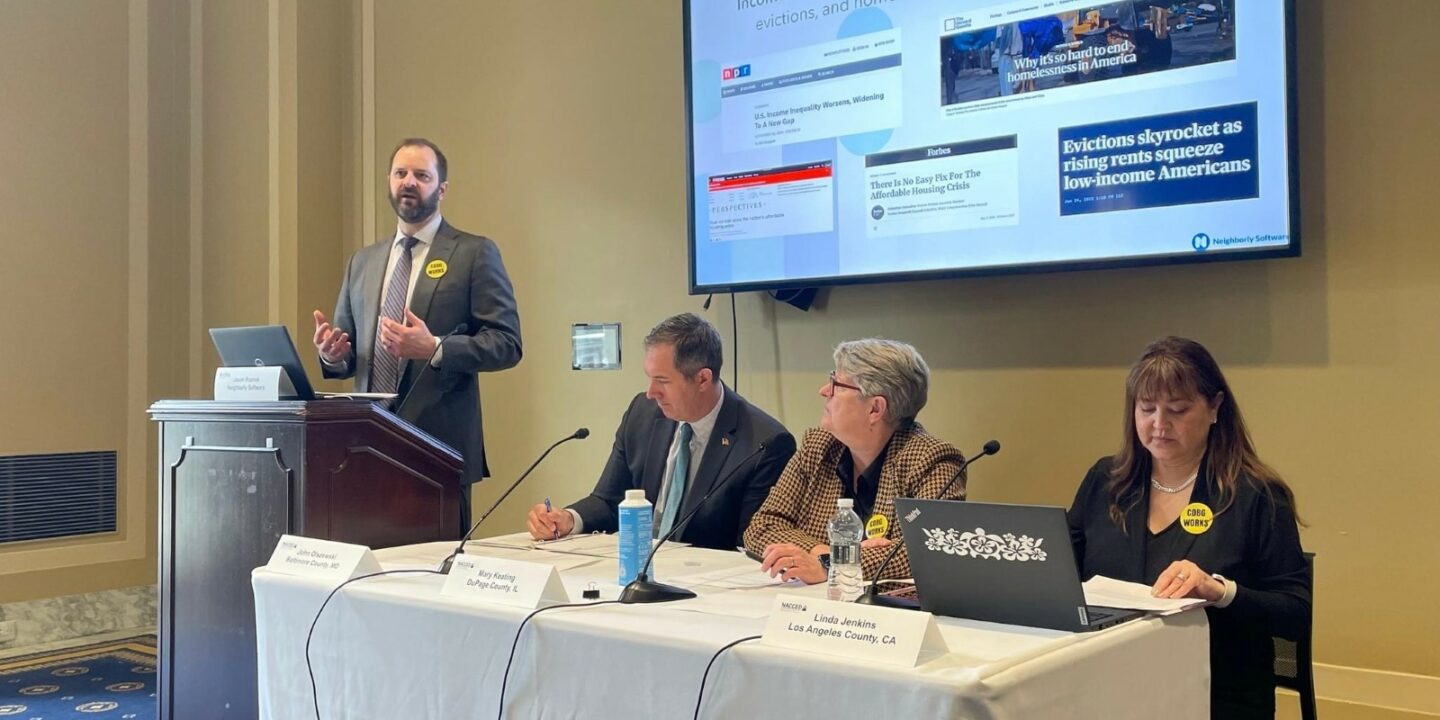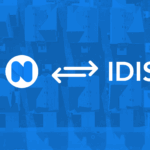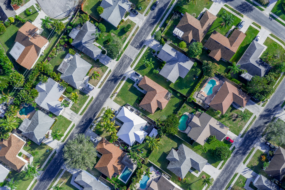
Last month, as we recognized Community Development Month, we also celebrated the 50th anniversary year of the Community Development Block Grant (CDBG) program. And we were lucky that our team at Neighborly Software was able to attend National Community Development Week events in Washington D.C., hosted by the National Community Development Association (NCDA).
This year was especially exciting, given the landmark anniversary, so it was a great backdrop to reflect on the program’s ongoing relevance, lasting impact, and potential for the future.
Established in the 1970s, CDBG has been a pivotal force in creating positive change across the U.S., empowering local governments to tackle a variety of challenges from housing to public services.
In this post, we’ll take a closer look at the goals and achievements of the CDBG program over the past five decades, dig into some of the hurdles it’s faced, and discuss where it’s heading next.
What is CDBG and Why It Was Established
The Community Development Block Grant (CDBG) was established as part of the Housing and Community Development Act of 1974. The primary goal in establishing CDBG was to give communities better access to resources that are necessary for effective community development. As they say on the CDBG website, they want to “build stronger and more resilient communities.”
Some of the ways that CDBG funds are meant to be put to use include projects that help provide:
- Decent, safe, and sanitary housing
- Suitable living environments
- Expanded economic development opportunities, especially for Low-Moderate Income (LMI) people
One of the groundbreaking aspects of CDBG was its shift towards localized decision-making. Previously, there were 8 other programs that were meant to address community needs, and they were all consolidated into this single, flexible block grant.
Unlike the categorical grants it replaced, which were narrowly focused and came with strict requirements, CDBG gave communities broad funding that provided more flexibility.
This move gave local governments the freedom to use these funds in ways that best met their specific community needs, rather than being tied nation-wide standards. Essentially, CDBG acknowledged that different communities have different needs, and they entrusted local governments to know what’s best for their citizens.
Eligibility for CDBG Funds
For activities to qualify for CDBG funding, they must meet the eligibility criteria laid out under 24 CFR 570 and meet one of the three national objectives, which are:
- Benefit low-and-moderate income (LMI) people
- Help to prevent or eliminate slums
- Address conditions that pose a severe and immediate threat to the health/safety of residents
The national objective addressed by CDBG activities is most commonly the first (benefitting LMI people), but occasionally #2 is addressed, only if there is a certified slum and blight neighborhood. The third objective is the rarest for programs to address. So, CDBG is most commonly thought of as a poverty alleviation program, due to the issues that the programs tend to address.
Achievements to Celebrate
In the past 50 years, the CDBG has accomplished a lot and inched the nation closer to the goal of stronger, safer, healthier communities.
Since 1974, HUD has issued Community Development Block Grants totaling more than $160 billion. And those billions of dollars haven’t been spent in vain. Just between FY2005 to FY2023, the CDBG program has met the housing needs of over 1.9 million households.
But numbers alone can’t demonstrate the true impact that this program has had on real communities. So let’s dive into some of the tangible change that CDBG has made over the past several decades.
Development of Affordable Housing
While homelessness recently reached an all-time high, that doesn’t mean that great strides haven’t been made in the development and preservation of affordable housing. Given that housing shortages are one of the main causes of homelessness, the ability to create any additional affordable housing can have a real impact on homelessness rates.
Some of the most successful CDBG projects have involved rehabilitating and converting old or non-residential buildings into housing for LMI individuals.
For example, in San Francisco, the historic Hotel Isabel was renovated and converted into 49 affordable apartment units.
A similar project happened in LA with the Hotel Cecil. Once an abandoned, rundown hotel (albeit with a colorful history), it was converted into affordable housing for 600 low-income individuals with single-room occupancy units and efficiency studios.
Infrastructure Improvements
Infrastructure, though not as in-your-face as more hot-button issues like housing, is an essential part of resident’s safety, health, and overall quality of life. CDBG funds have gone towards helping communities undergo several large-scale infrastructure projects to keep their communities thriving.
One great example of one of these projects happened in Akron, Ohio. The City of Akron used CDBG funds to overhaul their aging sewer system. This not only improved the quality of the city’s water, but it also reduced the risk of flooding in older neighborhoods.
Economic Development
CDBG activities give communities an incredible opportunity to support the growth of businesses and jo opportunities, which helps to strengthen the local economy and enhances the resiliency of the community. These types of projects can not only address immediate employment needs, but can also set the stage for long-term benefits and stability.
In Greenville, South Carolina, for example, CDBG funds helped the community establish a small business development center. The center provides training, mentoring, and financial assistance to local entrepreneurs, which helped to create new jobs (both for the entrepreneurs and for the people they went on to employ) and revitalized downtown areas.
Community Building
Let’s go back to one of the major aspects of the goal of the CDBG program: a strong community. One of the key components of a strong community is connection and togetherness. Many CDBG programs are designed specifically to strengthen these bonds in the community and enhance the collective spirit of residents. These projects often focus on creating or revitalizing spaces where people can come together, fostering a stronger sense of belonging.
The city of Abbotsford, Wisconsin provided a great example of how this looks in practice. Using $225,000 of CDBG funding, the city transformed a historic site, once home to a railroad depot, into a community center that housed a library, a public learning center, a community room, and the city hall.
Prominent local fundraisers really pushed for the building to follow a railroad theme to preserve the history of the site. So, what they ended up with is a space that celebrated the history of the city where several generations of Abbotsford residents can come together and connect.
Public Services
CDBG funds also often help to fund essential services that may be otherwise underfunded or unavailable altogether. Many of these programs touch on issues surrounding education, health, and safety.
After school programs are one type of program that often gets neglected in low-income communities, but given education’s critical role in shaping the youth’s future, these programs are critical for a strong community.
In Dallas, Texas, CDBG funds have helped to support after-school programs for at-risk youth. Thess programs do much more than just keep kids busy after school. They provide tutoring to foster academic achievement, career guidance to prepare the kids for future success, and recreational activities to promote both physical health and social skills.
As a result of these programs, there’s been a positive impact on the community, with lower dropout rates and better educational outcomes in underserved communities.
Current Challenges and Legislative Landscape
Despite the widespread success of CDBG, that doesn’t mean that it isn’t up against some key challenges.
Funding uncertainties
The amount of funds allocated to CDBG activities are at the whim of federal budget decisions and priorities, which can vary significantly from year to year depending on the administration in power and the economic climate.
For example, in the 1980’s, under the Reagan administration, there was a significant reduction in federal spending for urban development programs, including CDBG. Compare this to the majority of the 2000’s, where the economy and political climate were relatively stable, and CDBG funding followed suit.
Given the fact that we’re coming up on a presidential election this year, as well as the economic uncertainty we’re facing, the level CDBG funding that jurisdictions receive in the upcoming year may or may not look similar to amounts in previous years.
Adapting to evolving needs
The nature of what “community development” means is changing, so one challenge of the CDBG program is keeping pace with this evolution. Some new components to consider in community development programs are technology, infrastructure, and climate change.
For example, COVID was one of the biggest accelerants for investment in digital infrastructure, since so many things were suddenly shifted online. This brought about new issues for programs like CDBG to address, like digital education tools, healthcare, and the demand for reliable broadband access.
And on the climate change front, there’s perhaps an even bigger issue at hand. According to the National Oceanic and Atmosphere Administration (NOAA), the U.S. experienced a record number of weather/climate disaster events with losses exceeding $1 billion each in 2023. If climate disasters continue climbing at the current rate, increasingly more CDBG funds will be eaten up by this category alone.
Ensuring that the program remains relevant and responsive to these evolving priorities is one of the most important but also most challenging feats for those in charge.
Balancing flexibility with impact
Although flexibility is one of the biggest strengths of CDBG, and what sets it apart from programs of the past, this can also cause problems itself. While this flexibility provides local autonomy and potentially the ability to adapt quickly in instances like the ones we just mentioned above, this also opens the program up to the potential for misallocation and waters down the overall impact if it’s too diluted with lots of small projects.
Some critics also mention that the broadness may end up funneling more aid to businesses rather than the community as a whole, which has the potential to overlook the individuals most in need.
There are also some criticisms of the formula that’s used to determine which communities receive funding. Some people argue that this favors larger areas with larger populations, while smaller, rural areas who face equally pressing but different challenges, like a lack of basic infrastructure, may not receive sufficient funding under the current formula.
The Future of CDBG
Despite the challenges, we’re optimistic for a bright future for the CDBG program. After 50 strong years and countless communities changed, CDBG is positioned to continue to evolve in the right direction.
Here’s what we’re beginning to see on the horizon.
New legislation
The Yes in My Backyard (YIMBY) Act, which is a reaction to the Not in My Backyard (NIMBY) movement, is a legislative response to the affordable housing crisis that provides localities a framework for smart policymaking and regulatory practices that encourage more equitable housing options.
In contrast to NIMBY movements, which stigmatizes and seeks to eliminate dwellings like shelters, group homes, or section 8 housing, this act encourages local governments to eliminate discriminatory land use policies and remove barriers that restrict the development of affordable housing.
This act has a few key components, including:
- The promotion of zoning reform
- Incentives for reducing barriers that disproportionately affect LMI households
- Requirements for communities that receive federal housing funds to report on their efforts to reduce restrictions on housing development
- Support for diverse housing types, including affordable and high-density housing, accessory dwelling units (ADUs), and developments new transit hubs
The YIMBY (Yes in My Backyard) Act could have significant implications for the Community Development Block Grant (CDBG) program, particularly in how CDBG funds are utilized for housing and urban development projects.
It will likely lead to an enhanced focus on affordable housing initiatives. We may also begin to notice increased accountability and reporting by communities that are using CDBG funds. Overall, this act should only fortify the objectives that CDBG initially set out to achieve.
Emerging Trends
Sustainable infrastructure
There’s a growing emphasis on sustainability and climate resilience in community development that will absolutely impact the initiatives that CDBG helps to fund.
Going forward, we can expect to see a large focus on more “green” initiatives. This may include support projects that create sustainable infrastructure, energy-efficient housing, and other initiatives that help prepare communities for the impacts of climate change, as we touched on briefly earlier.
Leveraging technology for efficiency
Although government organizations are historically slow to adopt new technologies, many teams are beginning to slowly creep more towards the cutting edge, and there’s a growing trend towards using technology to create more efficiency in government agencies. CDBG teams are no exception.
Efficiency is especially relevant during times of funding uncertainty or even decreases, but even in the stablest of times, the teams that make the most impact are those that wield technology to make it easier to do their jobs.
Technology can improve the planning, implementation, and monitoring of CDBG projects, making the program more efficient and impactful.
Increasingly, teams are looking for purpose-built technology like Neighborly Software to manage all aspects of the CDBG program. There are a lot of moving parts, and it’s difficult if not impossible to keep track of it all using manual or even outdated technology.
With Neighborly Software, in one single, unified platform, you can:
- Review, accept, and score grant applications
- Allocate and track sub-recipient grant funding
- Submit invoices, accomplishment reports, and Section 3 reports
- Track program income
- Generate CAPERs report
And if you work on any government team, we don’t need to tell you how valuable it is to have much of the most tedious parts of your job streamlined by technology.
Here’s to 50 years!
We’re so inspired by all of the things that CDBG has been able to accomplish in just half a decade since its launch, and we can’t wait to see what the next several decades have in store. We’re proud to play a major role in the administration of funds from this program.









